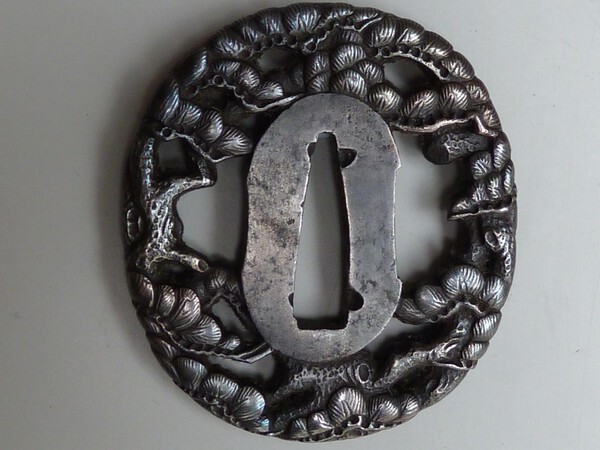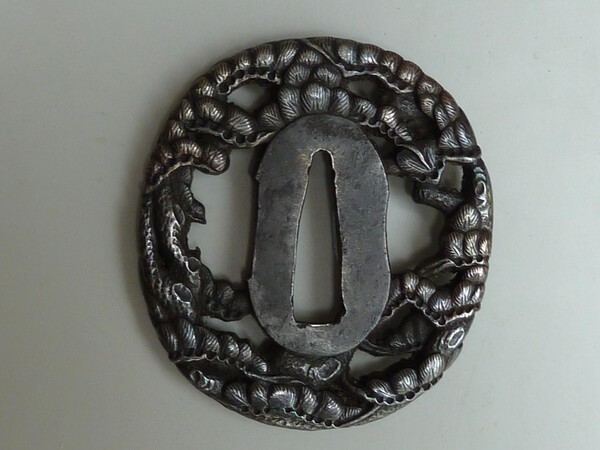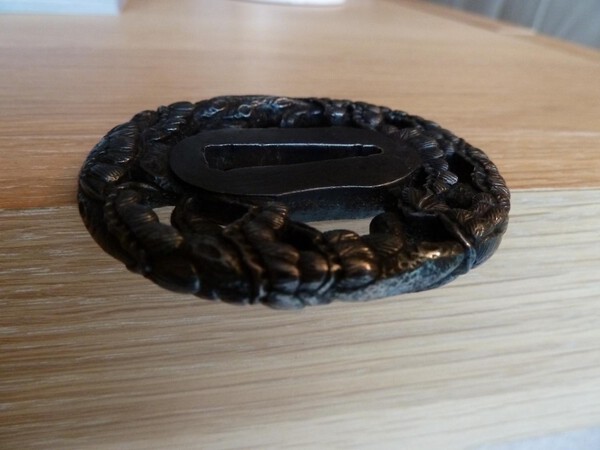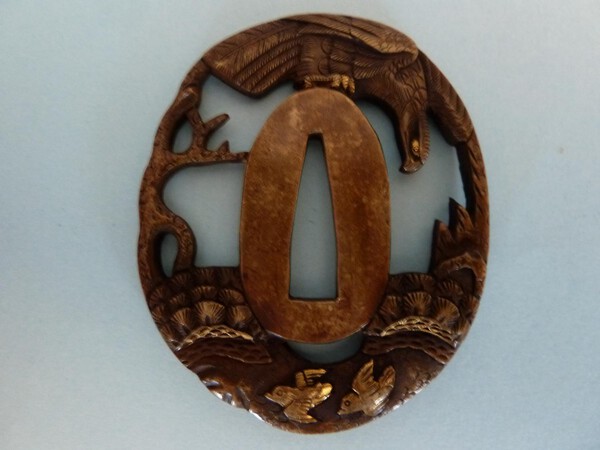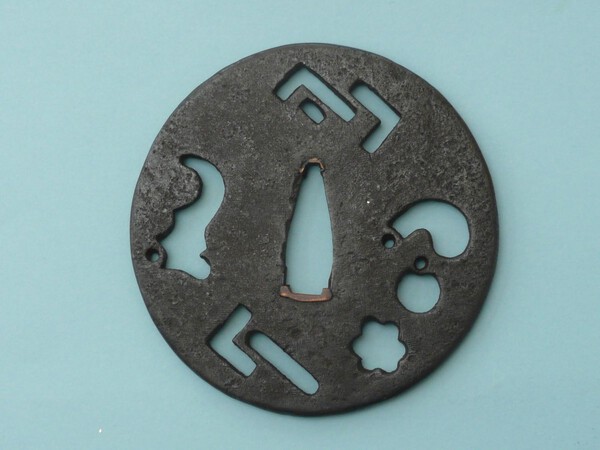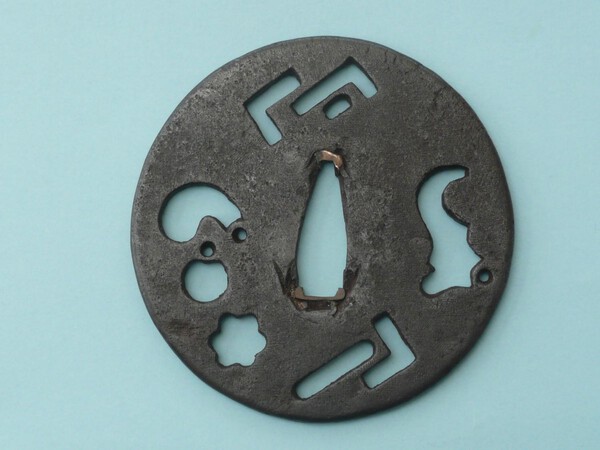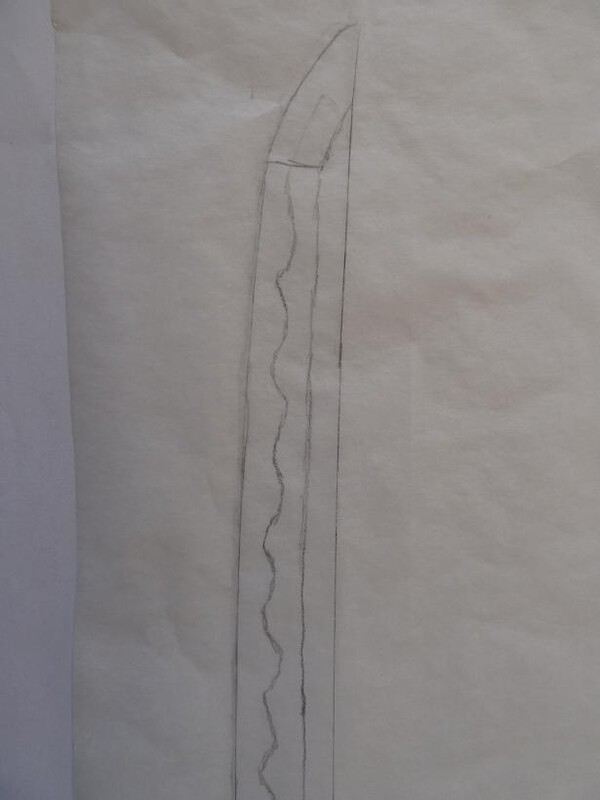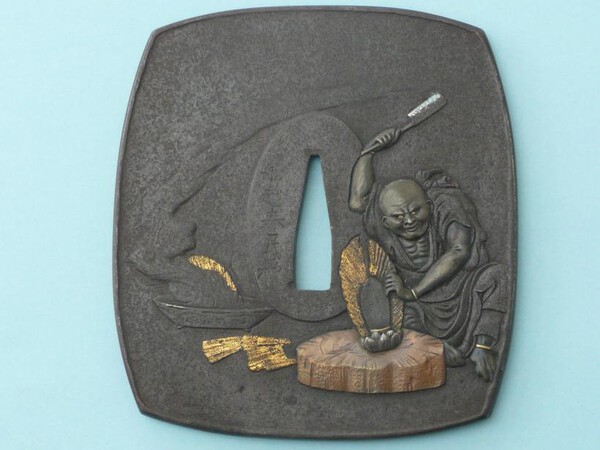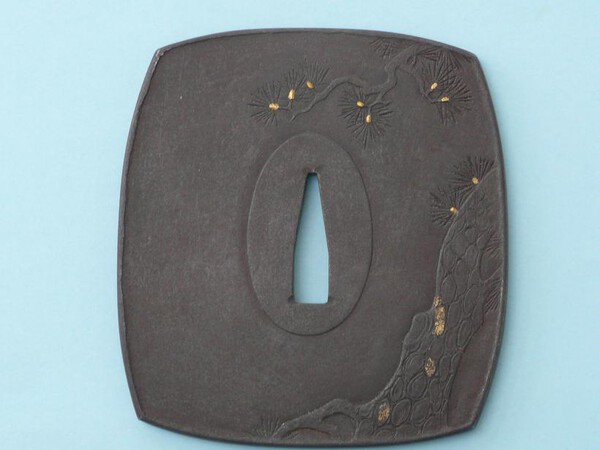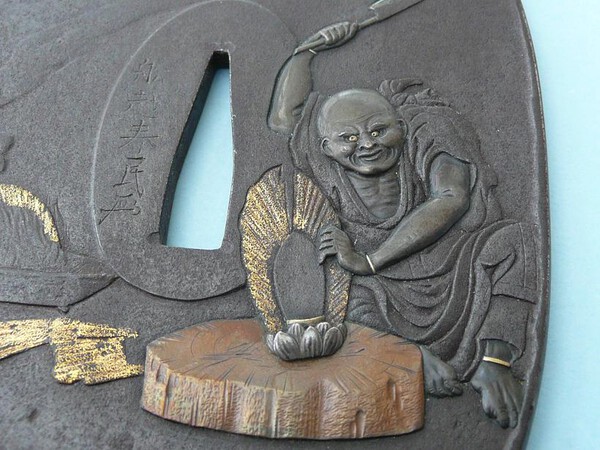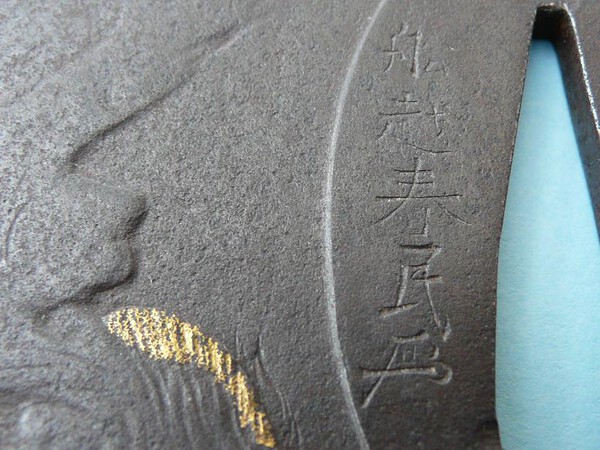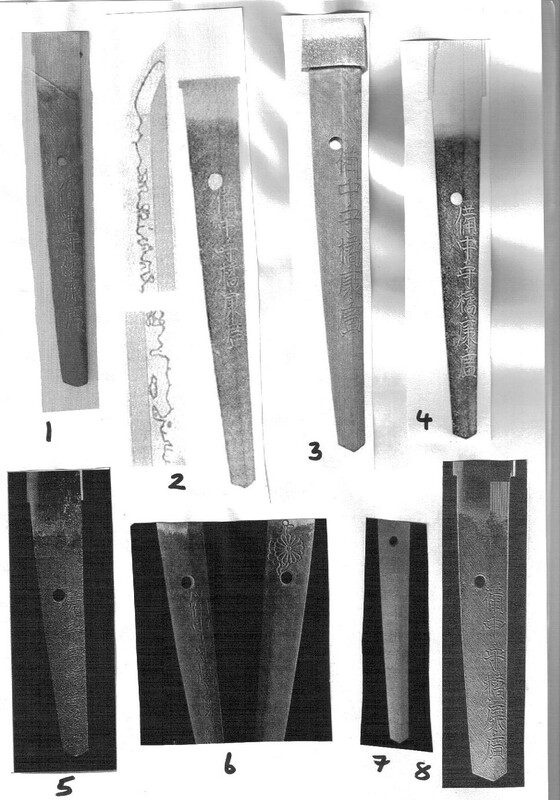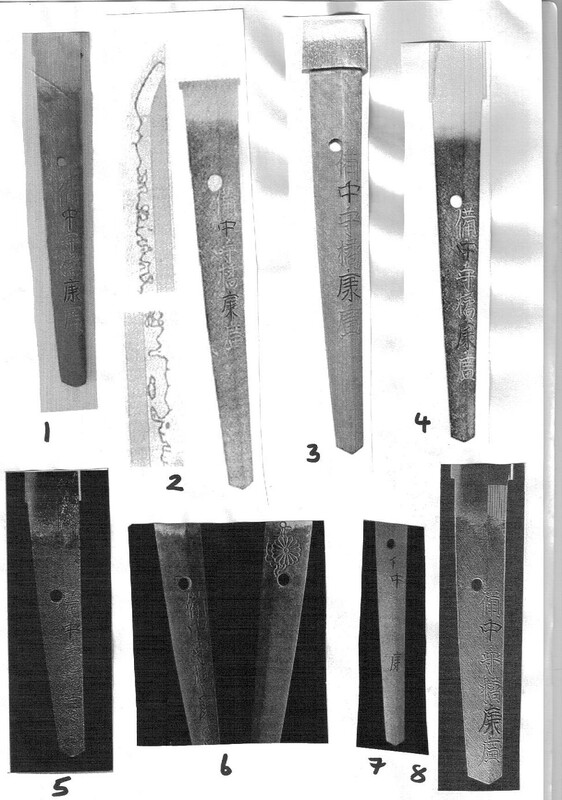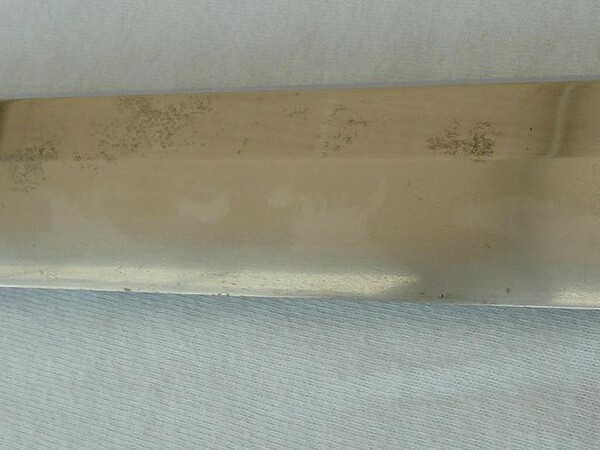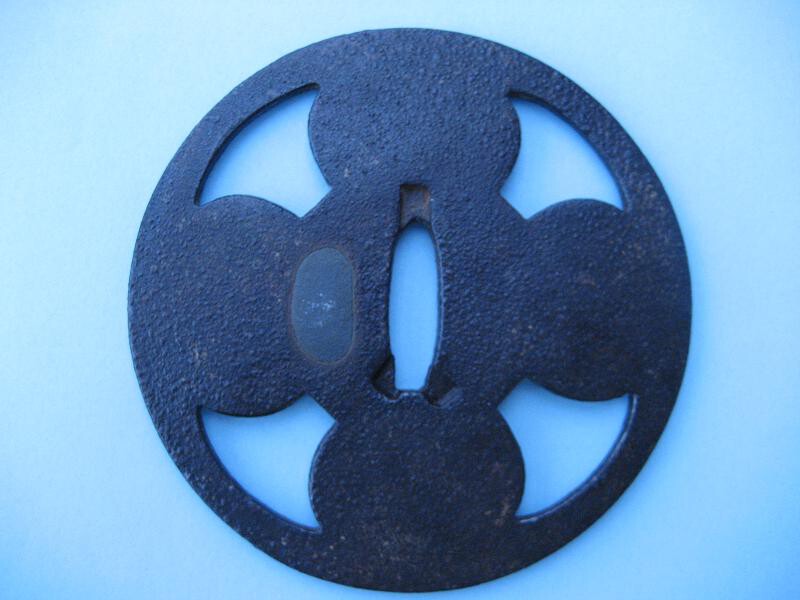
JohnTo
Members-
Posts
268 -
Joined
-
Last visited
Everything posted by JohnTo
-
Happy New year I have recently bought an iron sukashi tsuba with an unusual patina that I would like some opinions on (see three photos). The tsuba is wakizashi size (6.3 cm, 5.7 cm 0.6cm) and nicely carved in the round and pierced with a pine tree design. The nagako ana has scratches from a sword and punch marks indicating that this was once mounted, though the punch marks are often found on late tsuba purely as a form of decoration. The tsuba is unsigned and my initial guess was that it is 19th C Bushu or Echizen work. However, probably it is a cast piece that has been finished off by hand as the form is similar to a 19thC cast and carved brass tsuba that I have (see photo of my example and see an identical tsuba on Ebay [Matsukage, Dec 2016]). The unusual feature of this tsuba is the patina, which is outside my experience. It resembles a piece of silver which has blackened with age but has been regularly cleaned with a cloth, resulting in discolouration only on the inner surfaces. However it’s not silver, it is iron and magnetic (always good to check, I recently bought tsuba from a major auction house that was described as ‘bronze’ but was magnetic). Nor does it appear to be a case where the tsuba originally had a black patina which has worn away through use. The effect is uniform over all the surfaces. The piercings looked a little clogged and so I cleaned them out with a wooden tooth pick. The black specks that were removed were also magnetic (probably magnetite, Fe3O4), possibly indicating that the maker had been a bit sloppy in removing all the scale. The iron has no other traces of rust, except for bands of surface rust running along the mid sections of the piercings. The tsuba looks as if it could have been made yesterday, but was part of a job lot of 8 iron and soft metal tsuba plus fuchi-kashira and menuki that I bought at an auction. The lot looked like someone’s collection of better than average pieces from 17th-19thC. Looking closely, the shiny parts the steel shows a slight surface colouration that includes purple, steel blue, bottle green and copper red. The sort of effect seen in tempered or partially blued steel. I think that the patina is deliberate and original. Normally I would be overjoyed at finding an iron tsuba in such pristine condition, but as it appears to have been on a sword I would have expected some evidence of corrosion, especially on the metal with minimal patination. I have thought of the following possible reasons. Comments please. The tsuba is 19thC cast steel and subsequently carved and engraved by hand. Any original black patina was deliberately polished off the outer surfaces to produce the effect seen today, possibly augmented by tempering at the final stage. Subsequent owners of the tsuba treated it with great care and hence prevented corrosion. The tsuba is 19thC as reason 1, but was made of a non-corroding iron/steel. Proper stainless steel, with at least 10.5% chromium, was not invented until 1911. However, Stoddard and Farraday in about 1820, noticed that low chromium iron alloys were less liable to acid attack. Perhaps some enterprising Japanese tsuba maker was experimenting with new iron alloys from Europe or the USA? Apparently 0.1-0.4% copper, or 10-20% nickel, also improve the corrosion resistance of steel. Unfortunately, I do not have access to a X-Ray Fluorescence (XRF) spectrometer (unlike Ford Hallam) and hence cannot determine if other metals are present. Nor am I going to wrap the tsuba in a cloth soaked with saline and leave it for a month to see if it really is corrosion resistant. The tsuba was made in the early 20thC out of stainless steel, or some such alloy, possibly for use on a gendaito in a moist environment, e.g. jungle. It’s a completely modern tsuba that the previous owner of the collection picked up somewhere, simply because he liked it. Best Regards, John
-
The question has arisen as to why the polisher completed his (no doubt) expensive work on a blade with hagire. Made me wonder if the hagire developed after polishing. My reasoning for this is as follows. Much of the curvature on a Japanese sword occurs during yaki-ire when the mune shrinks more than the ha, resulting in a blade where the edge is in a state of tension. Hagire can develop during quenching when imperfections in the steel result in the tension pulling the steel apart. In this case the flaw may have not been sufficient to have resulted in hagire. However, during polishing, steel is removed from the ha, thus increasing the tensile load. Polishing also involves water, the great enemy of steel. Perhaps water seeped into minor flaws or spaces between the (martensite) steel grains during polishing, causing some corrosion within the steel after the polishing process had ended. The tensile loading in the ha, always present, may have caused the small flaw to increase, until catastrophic failure, metal fatigue, resulting in hagire. Rather like a car windscreen, where a small scratch can sometimes cause the windscreen to shatter months after the initial damage. Just a thought, John
-
Whenever I see a tsuba of this form (mokku shape, lightly hammered surface, mixed metal design in lower right quadrant, usually wakizashi size) in auctions they seem to be catalogued as Tanaka school. Not that the Tanaka school only produced tsuba in this style. What interests me is that, on the reverse, the decoration often appears to be a couple of small rocks lying on the ground (as this example) or a small plant in the lower left quadrant. Always seem to be a bit odd and nothing to do with the main subject. It appears that the artist was happy with the main theme and then just stuck something simple on the back. Any ideas why they should choose rocks?
-
I have a tosho tsuba with a couple of the same shape piercings. It was ex-R B Caldwell collection (Sotherby's march 1994, lot 14), see attached. The piercings were described as carpenter's squares, but I don't know what the curved ones represent. The tsuba is in good condition and the surface still shows fine crossed hatched file marks that the smith used to finish the tsuba. I've often puzzled as to what the shapes represent.
-
Ken, Thanks for the info regarding the silver coating. The product does not appear to be available in the UK, but I have found a similar one. John
-
Ian, Thanks for the comment. On my tanto fittings the chrysanthemums look firmly attached, but at each end of the tanto there are silver braches with gold flowers. These are not attached very well and the ends of the braches are free from the main body of the fitting and have obviously been applied with little thought to practicality (they keep snagging the bag it is kept in). I did see similar fittings on a sword at a London auction (Bonhams, I think) a couple of years ago. I'm sure you are right that at the end of the 19th C pretty little tanto were being put together for tourists incorporating a variety of skills which would not usually be seen on products for the samurai market. Bonhams (New York, Sept15) have a couple of Meiji tanto with cloisonne mounts (lots 3342, 3343). They don't bother showing the blades and one is just described as 'containing a tanto blade'. Down here in South West England I have seen a couple of such tanto coming up at our local auctions, possibly from the families of the original owners. Unfortunately, we cannot all afford Juyo rated items at the big auction houses and have to bid on what comes up locally. John B
-
Can anyone help with the identification of the swordsmith (Akikane) who made this Meiji period tanto? The blade (8.0 inch, 20.3 cm) is kanmuri otoshi in form with naginata style hi cut into the lower half of the blade. The hamon is togari ba in nioi with small patches of ko-nie in the tani. The jihada appears to be muji or possibly a tight masame (the apparent feint masame grain may be due to the polishing plus minute rust specs). The nakago is roughly shaped with a kenkyo tip and the yasurime are sujikai (sloping downwards from front to back) and seems to have been signed in a hurry (Akikane, see photo). This seems indicative of a smith in the Meiji period being told to produce an attractive blade for an uncritical foreign tourist clientele who would probably not appreciate the finer qualities of Japanese blades, but having spent a considerable effort in producing a complex shape was still proud enough of his work to sign it. So far, I have been able to identify a smith of this era with this signature. There do appear to be other smiths with the name Akikane in the literature, but use an alternative kanji for Kane (Gendaito smiths AK144, AK145 and AK146) The koshirai appear to be typical of pieces aimed at the tourist market in the Meiji period, rather exuberant, but demonstrating the skills of the metalworkers, who were made redundant after the wearing of swords was banned in 1876 (just because these kinko artists no longer made items for the samurai did not mean that they did not turn out some superb soft metal works of art, e.g. the bronzes coming out of Miyao Eisuke’s workshop in Yokohama). In this case the koshirai are based upon silver plate with embossed and engraved sparrows and branched of blossom, with touches of gilt finishing. The fuchi/kashira/kurikata etc are all matching in copper with a black (shakudo?) ishime finish embossed with silver chrysanthemums and gilt borders. None of the pieces of the koshirai are signed, but overall an attractive little tanto. In such pieces the blade was usually of secondary importance. Sometimes an old blade would be utilised but, at the other quality extreme, a simple blade would be made with an etched hamon. This blade seems to be contemporary with the fittings and the difficulty in polishing such a complex shape would indicate that the forging had some artistic merit over many other blades made for such pieces. The ‘Aki’ part of swordsmith’s names seems to have become common around the Meiji era. Kuihara Akihide’s father established the NihontoTanren Denshusho at Akasaka in Tokyo around 1893. Akihide’s teachers were Inagaki Masanori and Horii Taneaki. Akihide taught many Gendai smiths including Amada Akitsugu, Akimoto Akitomo and Miyairi Akihira. All of these smiths (and others from this densho) used the same character for Aki as this example. This, plus the associated koshirai would lead me to speculate that Akikane was working around 1890 in Tokyo, but I can find no reference to him anywhere. It’s quite probable that Akikane quit swordmaking around this time due to lack of demand, but he may also have continued working under a different name. Can anyone help? While we are on the subject of this particular tanto, can anyone give advice on stopping the silver of the koshirai tarnishing further without causing abrasive damage? Thanks, John
-
Thanks to everyone, the replies were very useful. So the reading of the location is likely to be Toshima. The different phonetics are always a problem with kanji. I know that even the simplest kanji (ichi for one) can be read in five different ways, plus additional slight variations, depending upon the context. Tegarayama Masashige was my second choice of school (well I would say that wouldn’t I?) but his works are described as having a ‘good deal of ashi on both sides’. I can’t see any, but they may have been polished away. I’m really impressed with the knowledge out there on the Nihonto Message board. It’s no wonder that when I see a poorly described Japanese sword item come up at some local auction I inevitably find myself bidding against someone on the phone who has also seen a potential bargain. There are no bargains anymore. This particular blade was described as a 20th C tanto, signed with two mounting holes. The ‘two mounting holes’ first got me interested. As an added bonus the fittings were interesting (see photos), a nambam tsuba and a shakudo nanako fuchi-kashira set with a minogame (sea-weed trailing turtle), signed/inscribed Furukawa Yoshinaga (I gather Sabei Yoshinaga studied under Goto Ryujo and was the most famous representative of the Furukawa line, thus making the signature suspect). Even the menuki are nice, shakudo horse fittings, so overall I was pleased with the package, despite paying over the maximum estimate.
-
Can anyone help me with a couple of queries regarding this wakizashi by Masatomo My translation of the signature (see photos) is: Bunshima (or Bujima etc.) Minamoto Masatomo Bunkwa hachinen nigatsu hi (a day in February 1811) My first question is what is the correct reading of the first two characters for the smith’s home location, ‘Bunshima’ and where is it in Japan? The first character in the signature appears to be #89 in the Robinson’s ‘The Arts of the Japanese Sword’ Appendix C list for the provinces as in Bu-zen and Bun-go in the Saikaido, Western Sea Circuit (Robinson’s #s 61 and 62 respectively). The second character is Jima, Shima (for an island) or To (On reading). However I cannot locate anywhere in Japan with the place name Bunshima, Bunjima, etc. Can anyone help here? The second question is can anyone help with information about the smith? The Nihonto Notice Board JSL index lists 3 swordsmiths named Masatomo, none of which use the same kanji for ‘Tomo’ or were working around 1811. The blade is 30.7 cm (12.1”) with a shallow tori sori (0.5cm) of standard shinogi zukuri construction. Although in good condition it has been overcleaned, but still shows the feint outline of the hamon (see photo of tracing), which I would describe as toran formed by a 2-3mm wide cloud of nie. There appears to be kinsuji and a tapering yakidashi at the base. There appears to be a ko-itame grain to the steel, but no trace on ashi in the hamon. Hopefully repolishing will reveal the hidden beauty in the steel. I would surmise that the blade has a strong Soshu influence based upon the Shinto smith Sukehiro, a style which I understand became popular at the start of the Shinsinto period. My guess is that the smith may have belonged to the Masahide school.
-
Thanks for the replies, especially from John L. I'm assuming that the references that John gave are from Haynes, which unfortunately I don't have. There was a comment about the design overflowing into the seppa dai. There are also decorative punch marks on the reverse, indicating that the nakago ana has been modified to fit a balde more tightly. I often see this in 19th C tsuba that were made as works of art and never intended to go on swords, even though they may have copper inserts and punch marks around the nakago ana. I assume that these were put on to enhance the feeling that the object is in fact a tsuba and not just a decorative piece of metal.
-
Minkoku/Shunmin Tsuba Can anyone help with the maker and subject of this tsuba? I bought this tsuba at a London auction nearly 20 years ago. Its signed Funakoshi Shunmin (with kao) and the artist was also listed as ‘Ikedo Minkoku, son of Someya Chomin and a pupil of Kono Haruaki’ with the dates 1833-ca. 1909. (other references give 1828-1816). The tsuba is iron (8.5 cm) with copper, silver and gold details. Whether or not the tsuba is an authentic piece by Funakoshi Shunmin, the carving of the figure’s robes in particular is of exceptional quality (in my opinion). The main subject was described as ‘a disaffected priest cutting the mandorla of a Buddhist statue with a cleaver’ and it was this that attracted to me to the tsuba as I recognised this as being a representation of the famous tale of the Chinese Zen monk Tanka (Tan’hsia, 739 -834, or 824) who stopped overnight at Yerenji. As it was freezing, he took down one of the wooden carvings of Buddha, chopped it up and set fire to it keep him warm. Next morning, the head monk of the temple was a little upset, to say the least, and berated Tanka, who started to rake through the ashes saying he looking for the bones (or sairas) of the cremated Buddha. The head monk called him an idiot (or something like that), informing him that there would be no cremated bones, as it was just a piece of wood. To which Tanka replied, ‘Well, if it was just a piece of wood, hand me down another carving and I’ll burn that as well.’ I particularly like the demonic look in Tanka’s eyes and when I purchased the tsuba, it had been over cleaned and his face was bright silver, but has now tarnished, as has the copper chopping block. The silver? Edge to the cleaver has remained bright. The gold on the mandorla has been lightly applied (I think the technique is called kakihage). Obviously this tsuba was never intended to go on a sword was made purely as an object d’art and I would guess that it was made around 1900. So onto the questions. Ikedo Minkoku/Funakoshi Shunmin (or Shumin) seems to be well documented, but not very well in any references that I have. The Genealogy charts of Markus Sesko lists a Shumin as the second (possibly third or fourth) son of Shomin of the Unno Shomin school. The Boston museum (see Lethal Elegance, Joe Earle) has a tobacco pouch with metal work made by him and signed Ipposai Minkoku, but unfortunately this was one of the few examples in the book with no photo of the signature. The British Museum has a shibuichi inro case signed Funakoshi Shunmin saku, with differences in some of the kanji to my tsuba (different hand or just change with time?). There seems to be various netsuke, inro, tobacco pouches, silverware made by Minkoku/Shunmin (with various Romanisation spellings and maybe not all the same guy), but I can find no tsuba, fuchi, kashira, etc. Also, my tsuba is iron, yet he seems to have specialised in soft metals. I have never come across any other kodogu by him in auctions. The spellings of the names mentioned above are as written in the references that I found and I’m assuming that these are just differences in Romanisation rather than differences in actual artists, but I may be wrong. I appears to me that the artist trained as a kodogu maker, saw that the age of the sword was coming to an end and switched to making ornamentation for the ‘fashion’ market. He also seems to have alternated between signing Minkoku and Shunmin, but I’m not sure why. Any info on this artist or his sword fittings would be appreciated. Thanks, John
-
I’m sure you’re right. It’s a cast tsuba. Had it been copper based, rather than iron, I would probably have quickly come to that conclusion without your help. Casting would also explain the patina. I’ve always thought that casting iron into a small mould would not have been an easy task (compared to copper) and considered casting iron tsuba to be a commercial waste of effort in the ‘reproduction’ market. For this reason I tend to be a lot less wary of iron rather than soft metal tsuba. Friends often point out Chinese soft metal tsuba to me in antique markets, but I’ve never seen an iron one. Not that I think that this is a modern Chinese tsuba. One of the likely schools that I had thought the tsuba may have come from was Yagyu (as suggested),or Kanayama, but the quality was not there. In view of the metal (iron) and the similarity to Yagyu, I’m inclined to think that it is a 19thC Japanese cast tsuba intended for the export/souvenir market. It’s still a useful addition to my collection as it’s an example that I have not got (hopefully) and an educational piece. And don’t worry, I did not pay a lot for it. Thanks for the help.
-
I bought this wakizashi tsuba amongst a job lot at a local auction (photo 1). Size 6.4cm x 6.0cm. 0.7cm thick at rim, 0.4cm at seppa dai. It’s not a great piece, but has features that I think it reveals something about its manufacture. Overall it looks like just another rather crudely forged, unsigned, iron tsuba of no particular interest. I would not like to hazard a guess as to the school, it’s easier to say what schools it does not belong to, e.g. Kyo sukashi, Echizen Kinai. It probably could have been made in any of many smithies anywhere in Japan. Anyone like to make a guess? Firstly, the damage to the surface, rather than rusting, has resulted in flakes of the patina becoming detached. I therefore deduce that this thick layer of purple/black oxidation was produced by long exposure in a hot forge, rather than the thin patina seen in many tsuba, which has often rubbed away in parts. The second interesting feature of this tsuba is what would be described in a sword as mune aware. A definite crack mid-way along three sides of the tsuba can be seen (photo 2). The fourth side has several ‘pock marks’ and may indicate hard steel tearing apart along the seam (photo 3). The inner surfaces of the cut out design also shows distinct lines along the middle of the plate. In most cases the lines on the inner part of the tsuba appear as positive projections from the surface, rather than cracks (photo 4 and also the ‘fuzziness’ along the inner edges in photo 1). These projections may be iron squeezed out from the layers or rust preferentially forming along the seam. My interpretation of these observations is that the plate was formed by folding over a thinner plate in half. The inner steel may have been softer than the outer steel or possibly a softer steel was sandwiched in (like kobuse sword forging) and attention was focussed on sealing the outer rim of the tsuba. When the central section was thinned the softer core steel was squeezed out in the joins in the mid-section of the tsuba. I have never seen evidence for such steel folding in a tsuba before (other than tsuba with definite grain patterns), but then I tend to just take superficial looks at tsuba at auctions and only study those in my collection in detail. Maybe many tsuba are made from a final single folded piece of steel rather from cut out from a large stock plate (which may be forged and folded many times) and this example only shows the joins between the layers because of poor forging. Comments welcomed.
-
Thanks for all the replies guys, sorry it has taken me so long to respond, but I have other interests. The general opinion appears to be that this Yasuhiro is a gimei. One question that I have with this opinion is why would a faker want to copy the work of such an ‘average’ swordsmith? I say ‘average’ as Nippon-To by Inami Hakusui list swords from about 400 swordsmiths with values ranging from 1,000 to 100,000 yen (1935 prices). Yasuhiro (I) is rated at 6,000, which places him in the bottom half. If I were a forger I would be copying someone in the top 200. Robinson does not include Yasuhiro in the top 15 Shinto smiths. Not that I believe that the blade is by Yasuhiro I, more likely by Yasuhiro III (based mostly upon a hunch, as I can find no examples attributed to him, but the change in shape of the nakago jiri and more cursive style of the signature may be more consistent with a change in style over about 70 years ). Less likely the blade is by Yasuhiro II or a gimei Yasuhiro II (even less reason to copy II than I). Unfortunately, we in the West are limited in our reference material. Which brings me to the subject of forgery. I remember being told about 40 years ago by an experienced collector of an old Japanese saying, viz: ‘Out of every 10 blades bearing the signature Masamune, 11 would be fakes’ (nice gold inlay ‘Masamune’ tanto sold recently in London in Part I of the Wrangham collection!) and reading that the Shinshinto smith Kawabe Masahide was described by his detractors as being in charge of the ‘forging’ department. I also remember going to see the Stowe school ‘Yasutsuna’ (9th C) when it came up for sale (beautiful blade), but thought to be a Kamakura forgery, so forgery of Japanese swords has a long tradition. I imagine that forgery reached its peak in the 19th and first half of the 20th century when swordsmiths were struggling to make a living. I believe that the famous 19thC forger Kajimei started out by documenting oshigata of famous swordsmiths and so was able to copy their signatures quite realistically. Would he have changed the nagako jiri in view of his great reference material? I would expect that the majority of gimei made in the last 150 years would be shinshinto blades as the forger would not have to bother about aging the nagako (rust) and would also be familiar with the forging style, having possibly worked with the smith being copied. How prevalent was forgery in the Tokugawa era, which was effectively a police state with harsh penalties for breaking the law? Were daimyo complicit in running forgery smithies in their fiefdoms in exchange for a percentage of the profit. And what about today? With all new swords having to be registered in Japan and made by licensed swordsmiths what is the chance of a modern blade (say post 1970) being a forgery? Josh states that swordsmiths use an inked in signature before chiselling. I would also think that this was standard practice. Consider the Yasuhiros, nothing could be worse than to finish chiselling a chrysanthemum and finding that they were half a petal out! I was on an English brewery tour last week and visited the cooper’s section. Apparently, after finishing his apprenticeship, the cooper is given a token with his initials to use as a template when signing the beer barrels that he subsequently made. An ‘official signature template’ was probably common among (semi-literate) artisans worldwide. I can easily imagine the master of an apprentice swordsmith popping next door to the woodblock artist and having a signature stamp made for the new ‘journeyman’ to ink in on all swords that he made before chiselling out his signature (that is apart from any really good swords that apprentice made, in which case the master would sign and attribute these to himself! Are these gimei?) Hoanh and Chris say that the mekugi ana is in the wrong place and the hamon is atypical, having tobiyaki. The Nihon To Koza, vol V has a good section on gimei and shows two shoshinmei of Ishido Korekazu, dated just one year apart, in which the mekugi ana is above the signature in one example and right between the first two characters in the second. So, the placing of the mekugi ana does not appear to be a hard and fast rule with every smith. The example in Nihon To Koza has a suguha hamon and the one in Fujishiro has tobiyaki, so what is typical? It’s not that I am in denial regarding the authenticity, I just like to look at all angles, rather than just dismissing it as gimei because it is not a text book example of Yas I. After all, out of 100 Yasuhiro blades I would expect 30 Yas I, 30 Yas II, 30 Yas III and 10 gimei, from a simple statistical view. Of course a shinsa would be useful, but I live in the UK and I have another sword to have polished first (I don’t think this one is gimei as, although it is signed and dated, I can’t find the smith listed anywhere!) Thanks for all the comments, they are all valid and have prompted me to look into the question of gimei a bit deeper. So thanks for the stimulus. How many of us make sure the labels on our clothes are fully visible so that everyone else can see we only buy upmarket designer items, even though they are probably churned out in a sweat shop in Bangladesh? I’m always amused when I read about some piece of art, which has eventually been attributed to ‘the master’ (following a lot of pressure by the owner), rather than being a studio piece. Overnight the value may increase 100-fold, but the intrinsic artistic quality of the item remains unchanged. I suppose ‘the name’ is everything, in ancient times as now.
-
I logged onto the Nihonto Notice Board hoping to find some info regarding Yasuhiro and low and behold found this discussion. It was of particular interest to me as I believe that I was the guy that bought the sword in question. So let me add my thoughts. Firstly, let me say that I bought the sword because of what was on the other side of the habaki, though I must admit that the signature did make me put in a higher bid. Secondly I don’t subscribe to the assumption that the old kaji spent careers, often spanning several decades, paying particular attention to carving their signatures in exactly the same way and with the same chisel (unlike today’s smiths who are making swords for the art market). I guess that some were also semi-literate (better than their European counterparts though). All the signatures that I have seen (in print) show variations and being a statistician, who specialised in a field dealing with the identification of outliers within small sample populations, I’m reluctant to draw firm conclusions based upon these examples. I’ve attached a collage of signatures from various sources and these are as follows: 1> Sword under discussion 2> Shinto Shu by Fujishiro page 77 3> Sword for sale. (NBTHK Tokubetsu Hozon, Yasuhiro I or II) 4> Advert 5> Wakizashi in British Museum (ex-Lloyd collection 1958.07-30.144) shown in Cutting Edge #45 6> Advert (NBTHK Tokubetsu ‘higher’ to Yasuhiro I) 7> British Museum (ex-Lloyd collection 1958.07-30.141) also shown in Cutting Edge #43. In my opinion this blade has a rather deep sori (2.4 cm) for a 17thC blade! 8> Wakizashi Compton II lot 288 (NBTHK Tokubetsu Kicho to Yasuhiro I) All examples were signed Bichu Ju Tachibana Yasuhiro (some mention a Kiku but were not usually shown) and I’ve focussed on a couple of the characters for discussion, namely ‘Chu’ and ‘Yasu’ The ‘Chu’ in #1 is definitely the most curved and has the greatest disparity between the length of top and bottom horizontal strokes, though most of the other examples show fluidity to this character, with the exception of #6 which is rather rigid and angular. The character ‘Yasu’ in #1 has three horizontal strokes in the centre, much like examples 2, 3, 4 & 7. The ‘Yasu’ in #6 has very distinctive upward ends (ticks) to the horizontal strokes on the left character, far more than #8, Compton’s blade which also has an NBTHK TK paper. Couple this to the stem and leaf on the Kiku and I would have put this so far out of line with the other signatures as to be gimei! The Compton blade appears to have less distinctive ‘ticks’ to the end of the horizontal strokes in ‘Yasu’. My guess is that these two are Yasuhiro I and the other blades II & III. To my untrained eye the signature of #1 seems most closely related to 2 & 7 and the position of the first character in relation to the mekugi ana in 1 and 7 seems similar. Add to this the sugikai yasurime, but take off the more rounded tip of the nagako jiri and I’ve still got an open mind as to whether it is a genuine Yasuhiro II or III. If not, it is by someone familiar with the Yasuhiro style. However, all the discussion has been about the nagako. I bought the sword after just looking at the other end for just one minute. Despite the grubbiness, there was no serious pitting or edge nicks. The hamon was visible (see photos) and resembled example 2. Clouds of nie were clearly visible around both upper and lower parts of the choji midare hamon, which showed nice crab claws and tobiyaki floating above the low parts of the hamon. Itame hada from what I can see. The only unfortunate thing about this purchase is that, as it sold for maximum, I’m out of cash to have it repolished, something I feel this sword richly deserves.
-
For comparison I've attached a photo of a Tadatsugu tsuba in my collection, which I hope you will find useful. Description: An iron katchushi (armouror’s) tsuba in circular form with a shakudo mimi, the plate pierced on one side with a kirimon (paulonia badge). Signed Tadatsugu and accompanied by a NBTHK Tokubetsu Kicho paper dated Showa 43 (1968). This may be the Tadatsugu of the Umetada school in Yamashiro who died in the first month of Empo (1678). Purchased from Sotherby’s, London, 30 March 1994, Lot14 as Part of the R.B.Caldwell Collection. Height: 7.0 cm Width: 6.8 cm Thickness: 0.5 cm John
-
Thanks for the information. You are probably right about it being a modern copy, but the surface is different from any etched examples that I have seen. It was cheap, so it still makes an interesting addition to my collection. I remember being told of an old saying over 35 years ago 'Out of every 10 blades signed by Masamune, 11 are fakes.' Guess the same is true of tsuba to judge by the number of obvious fakes around. John
-
Can anyone give me information about the surface patina on a tsuba I have recently acquired? I bought the tsuba on-line and thought that it was just a rusty tosho tsuba. However when it arrived I realised that this was like no 'rust' I had seen before. The entire suface is covered with small bumps, resembling a toad's skin, or piece of same used on sword handles. It looks like the iron has been heated to a very high temperature and started to boil, before quenching. The surface has a shine to it, unlike corrosion and I don't think it has been lacquered or given a thin coat of polyurethane. I can find no similar examples in books or sales catalogues. The tsuba has a simple , symmetrical, pierced design, possibly of four axe heads in negative silhouette, or four circles in positive silhouette around a central circle. The hitsu ana is plugged, probably with lead, or possibly a tarnished silver metal (pewter or silver). Overall, the tsuba is large, indicating that it is old (before 1550?). The plate is not flat, but convex on both sides a shape is known as go-ishi gata (go stone shape) and appears skillfully executed as the convex surfaces are very even. Height: 9.2 cm, Width:9.2 cm, Thickness at rim: 0.2 cm, Thickness at Seppa Dai: 0.5 cm. Thanks for any information you can give me, John

